Determinants of market supply and demand affecting the long term revenue management strategy
VerifiedAdded on 2023/01/12
|7
|1397
|80
AI Summary
This article discusses the factors that affect the price elasticity of demand in the hospitality industry, the effects of an increase in vegetable prices on market equilibrium prices, the use of tax cuts and government purchases as expansionary fiscal policy, how restaurant operators can maximize revenues using cross price elasticity of demand, and the points of product differentiation for a five-star hotel in Sydney CBD. It also explores the determinants of market supply and demand that affect long-term revenue management strategies.
Contribute Materials
Your contribution can guide someone’s learning journey. Share your
documents today.
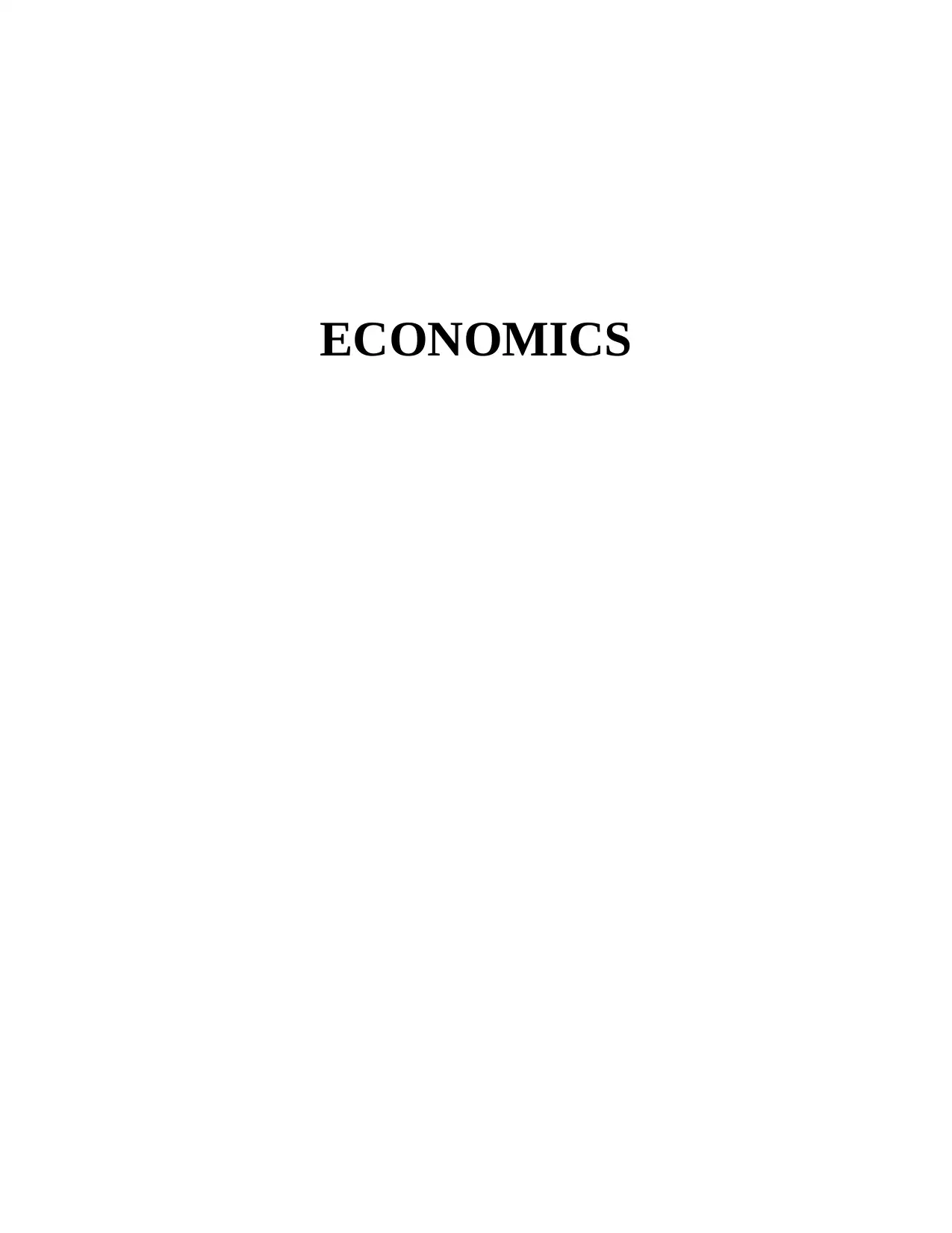
ECONOMICS
Secure Best Marks with AI Grader
Need help grading? Try our AI Grader for instant feedback on your assignments.
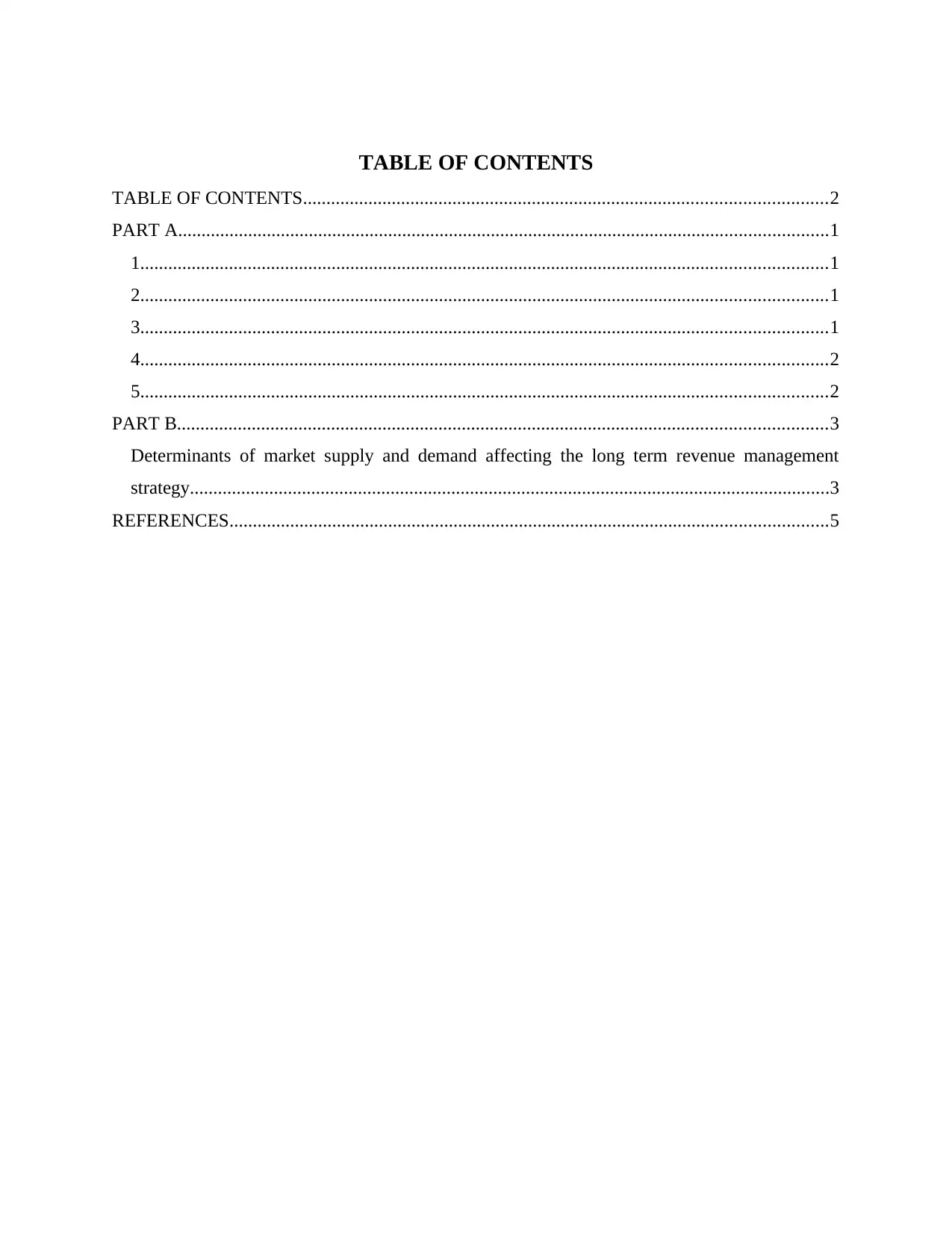
TABLE OF CONTENTS
TABLE OF CONTENTS................................................................................................................2
PART A...........................................................................................................................................1
1...................................................................................................................................................1
2...................................................................................................................................................1
3...................................................................................................................................................1
4...................................................................................................................................................2
5...................................................................................................................................................2
PART B...........................................................................................................................................3
Determinants of market supply and demand affecting the long term revenue management
strategy.........................................................................................................................................3
REFERENCES................................................................................................................................5
TABLE OF CONTENTS................................................................................................................2
PART A...........................................................................................................................................1
1...................................................................................................................................................1
2...................................................................................................................................................1
3...................................................................................................................................................1
4...................................................................................................................................................2
5...................................................................................................................................................2
PART B...........................................................................................................................................3
Determinants of market supply and demand affecting the long term revenue management
strategy.........................................................................................................................................3
REFERENCES................................................................................................................................5
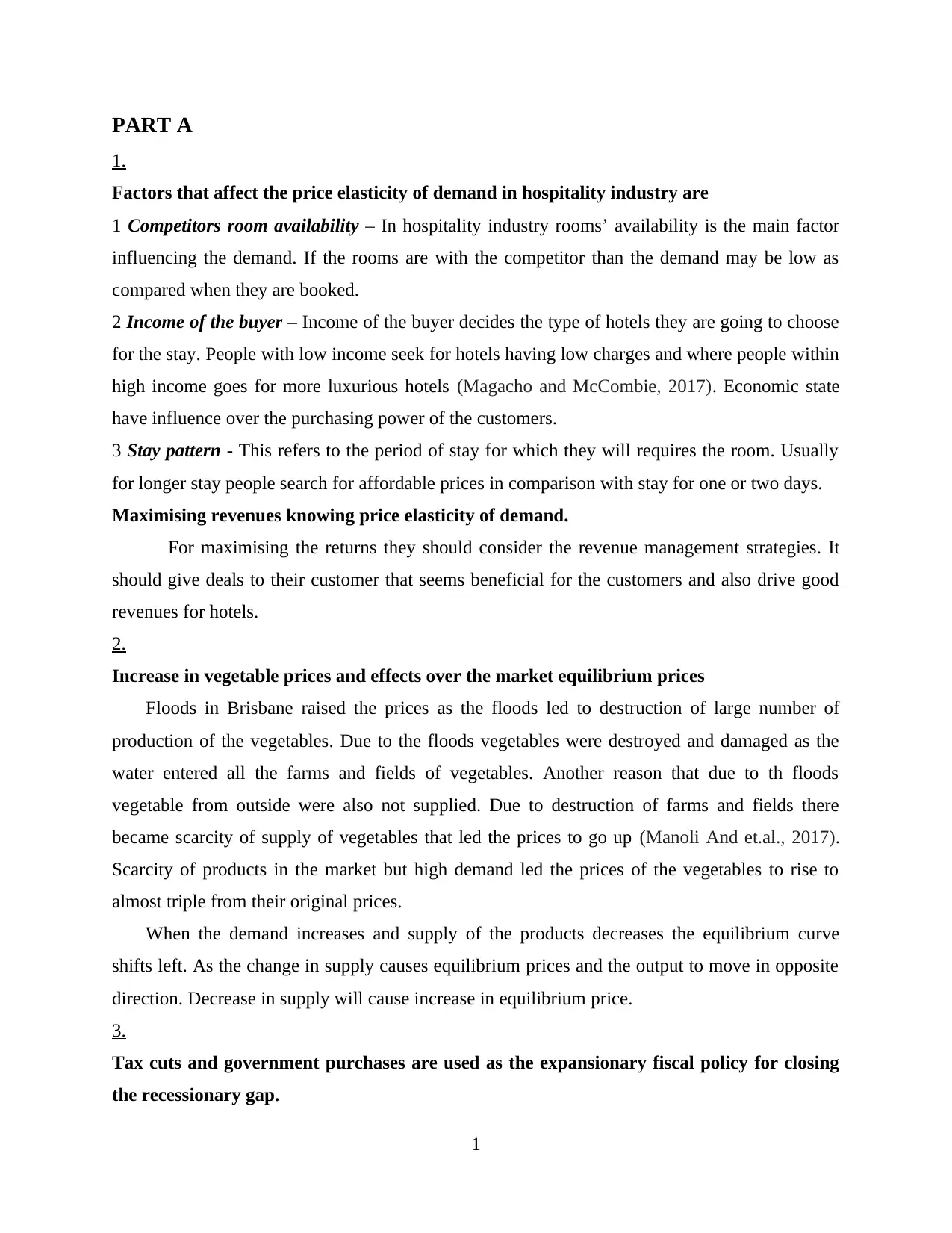
PART A
1.
Factors that affect the price elasticity of demand in hospitality industry are
1 Competitors room availability – In hospitality industry rooms’ availability is the main factor
influencing the demand. If the rooms are with the competitor than the demand may be low as
compared when they are booked.
2 Income of the buyer – Income of the buyer decides the type of hotels they are going to choose
for the stay. People with low income seek for hotels having low charges and where people within
high income goes for more luxurious hotels (Magacho and McCombie, 2017). Economic state
have influence over the purchasing power of the customers.
3 Stay pattern - This refers to the period of stay for which they will requires the room. Usually
for longer stay people search for affordable prices in comparison with stay for one or two days.
Maximising revenues knowing price elasticity of demand.
For maximising the returns they should consider the revenue management strategies. It
should give deals to their customer that seems beneficial for the customers and also drive good
revenues for hotels.
2.
Increase in vegetable prices and effects over the market equilibrium prices
Floods in Brisbane raised the prices as the floods led to destruction of large number of
production of the vegetables. Due to the floods vegetables were destroyed and damaged as the
water entered all the farms and fields of vegetables. Another reason that due to th floods
vegetable from outside were also not supplied. Due to destruction of farms and fields there
became scarcity of supply of vegetables that led the prices to go up (Manoli And et.al., 2017).
Scarcity of products in the market but high demand led the prices of the vegetables to rise to
almost triple from their original prices.
When the demand increases and supply of the products decreases the equilibrium curve
shifts left. As the change in supply causes equilibrium prices and the output to move in opposite
direction. Decrease in supply will cause increase in equilibrium price.
3.
Tax cuts and government purchases are used as the expansionary fiscal policy for closing
the recessionary gap.
1
1.
Factors that affect the price elasticity of demand in hospitality industry are
1 Competitors room availability – In hospitality industry rooms’ availability is the main factor
influencing the demand. If the rooms are with the competitor than the demand may be low as
compared when they are booked.
2 Income of the buyer – Income of the buyer decides the type of hotels they are going to choose
for the stay. People with low income seek for hotels having low charges and where people within
high income goes for more luxurious hotels (Magacho and McCombie, 2017). Economic state
have influence over the purchasing power of the customers.
3 Stay pattern - This refers to the period of stay for which they will requires the room. Usually
for longer stay people search for affordable prices in comparison with stay for one or two days.
Maximising revenues knowing price elasticity of demand.
For maximising the returns they should consider the revenue management strategies. It
should give deals to their customer that seems beneficial for the customers and also drive good
revenues for hotels.
2.
Increase in vegetable prices and effects over the market equilibrium prices
Floods in Brisbane raised the prices as the floods led to destruction of large number of
production of the vegetables. Due to the floods vegetables were destroyed and damaged as the
water entered all the farms and fields of vegetables. Another reason that due to th floods
vegetable from outside were also not supplied. Due to destruction of farms and fields there
became scarcity of supply of vegetables that led the prices to go up (Manoli And et.al., 2017).
Scarcity of products in the market but high demand led the prices of the vegetables to rise to
almost triple from their original prices.
When the demand increases and supply of the products decreases the equilibrium curve
shifts left. As the change in supply causes equilibrium prices and the output to move in opposite
direction. Decrease in supply will cause increase in equilibrium price.
3.
Tax cuts and government purchases are used as the expansionary fiscal policy for closing
the recessionary gap.
1
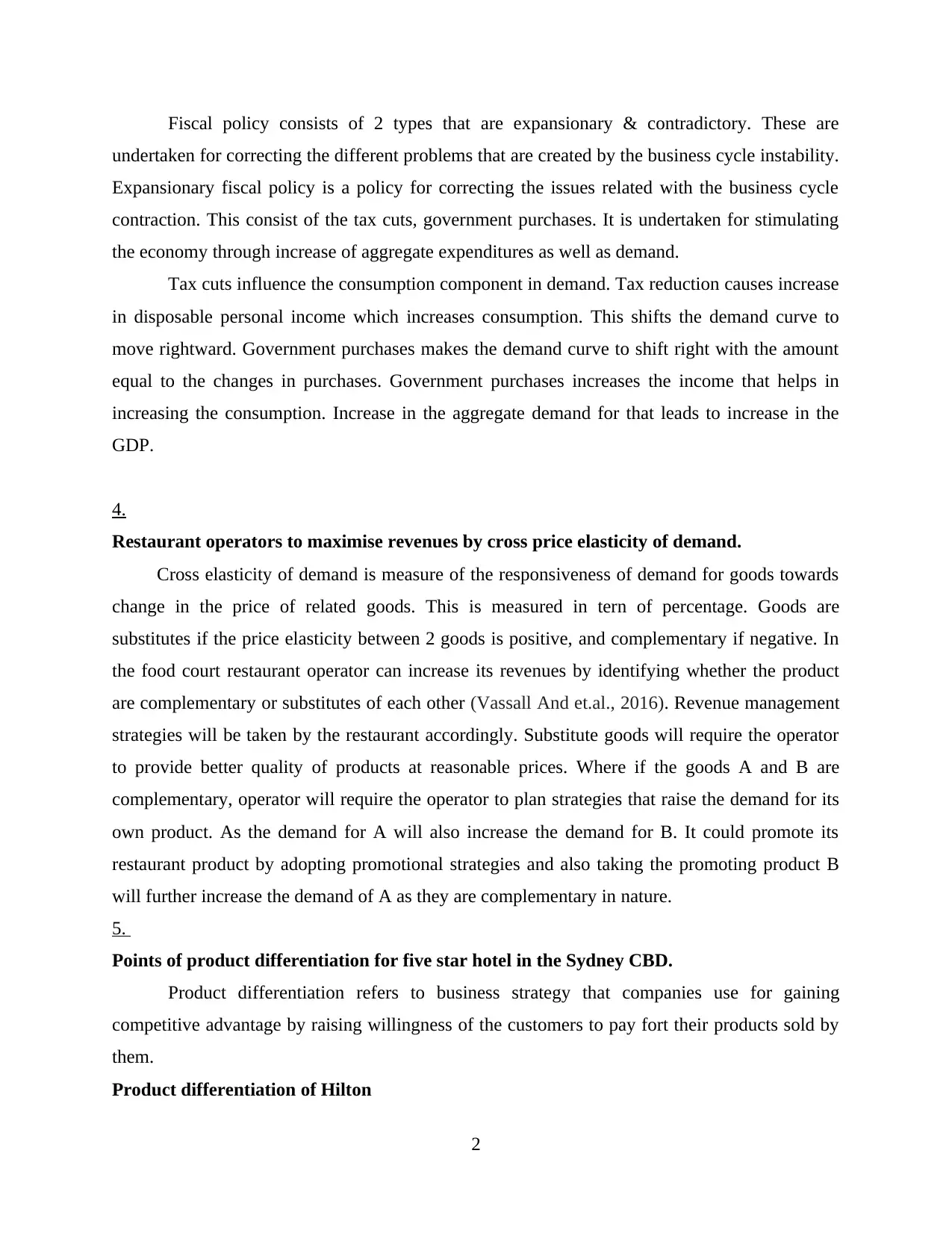
Fiscal policy consists of 2 types that are expansionary & contradictory. These are
undertaken for correcting the different problems that are created by the business cycle instability.
Expansionary fiscal policy is a policy for correcting the issues related with the business cycle
contraction. This consist of the tax cuts, government purchases. It is undertaken for stimulating
the economy through increase of aggregate expenditures as well as demand.
Tax cuts influence the consumption component in demand. Tax reduction causes increase
in disposable personal income which increases consumption. This shifts the demand curve to
move rightward. Government purchases makes the demand curve to shift right with the amount
equal to the changes in purchases. Government purchases increases the income that helps in
increasing the consumption. Increase in the aggregate demand for that leads to increase in the
GDP.
4.
Restaurant operators to maximise revenues by cross price elasticity of demand.
Cross elasticity of demand is measure of the responsiveness of demand for goods towards
change in the price of related goods. This is measured in tern of percentage. Goods are
substitutes if the price elasticity between 2 goods is positive, and complementary if negative. In
the food court restaurant operator can increase its revenues by identifying whether the product
are complementary or substitutes of each other (Vassall And et.al., 2016). Revenue management
strategies will be taken by the restaurant accordingly. Substitute goods will require the operator
to provide better quality of products at reasonable prices. Where if the goods A and B are
complementary, operator will require the operator to plan strategies that raise the demand for its
own product. As the demand for A will also increase the demand for B. It could promote its
restaurant product by adopting promotional strategies and also taking the promoting product B
will further increase the demand of A as they are complementary in nature.
5.
Points of product differentiation for five star hotel in the Sydney CBD.
Product differentiation refers to business strategy that companies use for gaining
competitive advantage by raising willingness of the customers to pay fort their products sold by
them.
Product differentiation of Hilton
2
undertaken for correcting the different problems that are created by the business cycle instability.
Expansionary fiscal policy is a policy for correcting the issues related with the business cycle
contraction. This consist of the tax cuts, government purchases. It is undertaken for stimulating
the economy through increase of aggregate expenditures as well as demand.
Tax cuts influence the consumption component in demand. Tax reduction causes increase
in disposable personal income which increases consumption. This shifts the demand curve to
move rightward. Government purchases makes the demand curve to shift right with the amount
equal to the changes in purchases. Government purchases increases the income that helps in
increasing the consumption. Increase in the aggregate demand for that leads to increase in the
GDP.
4.
Restaurant operators to maximise revenues by cross price elasticity of demand.
Cross elasticity of demand is measure of the responsiveness of demand for goods towards
change in the price of related goods. This is measured in tern of percentage. Goods are
substitutes if the price elasticity between 2 goods is positive, and complementary if negative. In
the food court restaurant operator can increase its revenues by identifying whether the product
are complementary or substitutes of each other (Vassall And et.al., 2016). Revenue management
strategies will be taken by the restaurant accordingly. Substitute goods will require the operator
to provide better quality of products at reasonable prices. Where if the goods A and B are
complementary, operator will require the operator to plan strategies that raise the demand for its
own product. As the demand for A will also increase the demand for B. It could promote its
restaurant product by adopting promotional strategies and also taking the promoting product B
will further increase the demand of A as they are complementary in nature.
5.
Points of product differentiation for five star hotel in the Sydney CBD.
Product differentiation refers to business strategy that companies use for gaining
competitive advantage by raising willingness of the customers to pay fort their products sold by
them.
Product differentiation of Hilton
2
Secure Best Marks with AI Grader
Need help grading? Try our AI Grader for instant feedback on your assignments.
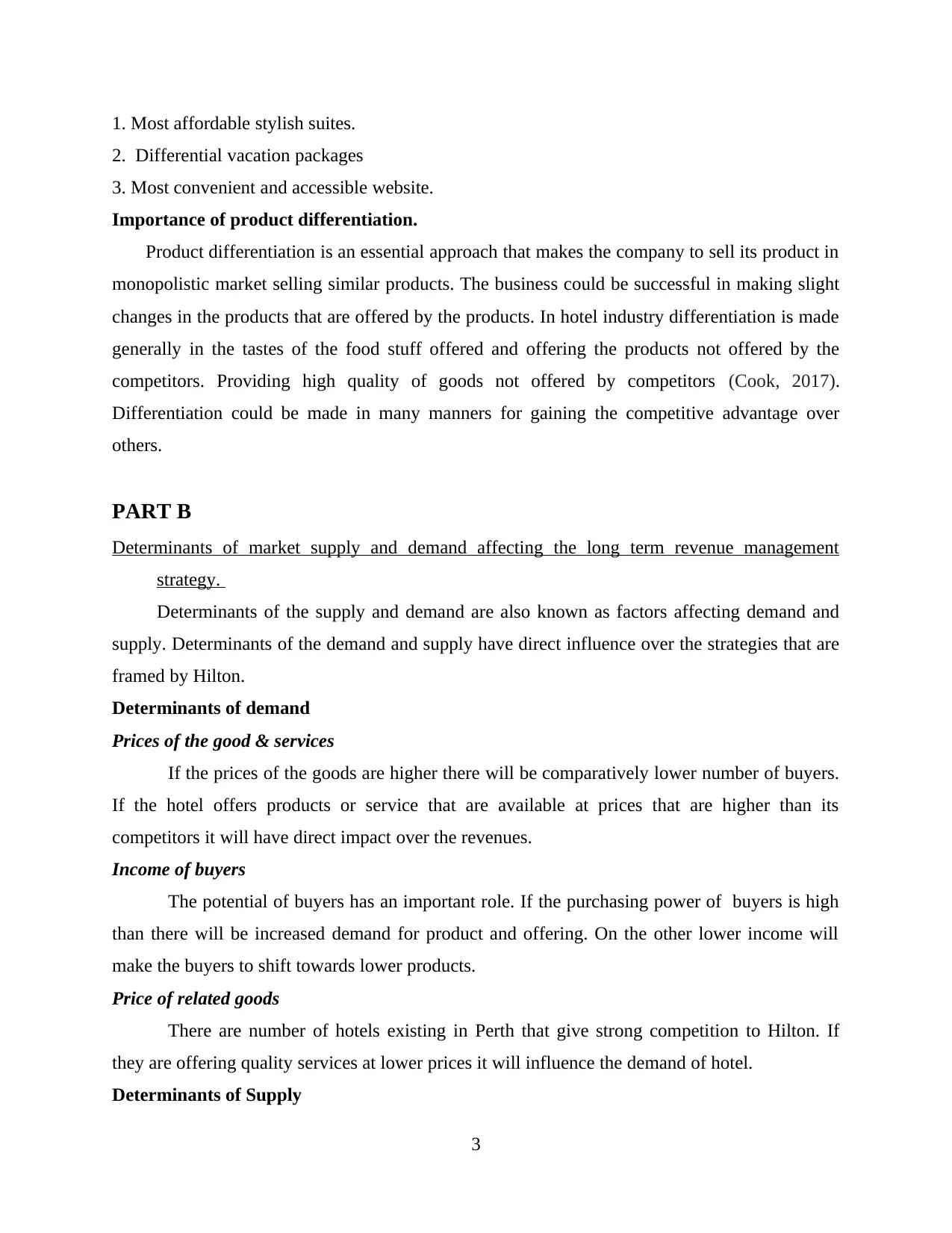
1. Most affordable stylish suites.
2. Differential vacation packages
3. Most convenient and accessible website.
Importance of product differentiation.
Product differentiation is an essential approach that makes the company to sell its product in
monopolistic market selling similar products. The business could be successful in making slight
changes in the products that are offered by the products. In hotel industry differentiation is made
generally in the tastes of the food stuff offered and offering the products not offered by the
competitors. Providing high quality of goods not offered by competitors (Cook, 2017).
Differentiation could be made in many manners for gaining the competitive advantage over
others.
PART B
Determinants of market supply and demand affecting the long term revenue management
strategy.
Determinants of the supply and demand are also known as factors affecting demand and
supply. Determinants of the demand and supply have direct influence over the strategies that are
framed by Hilton.
Determinants of demand
Prices of the good & services
If the prices of the goods are higher there will be comparatively lower number of buyers.
If the hotel offers products or service that are available at prices that are higher than its
competitors it will have direct impact over the revenues.
Income of buyers
The potential of buyers has an important role. If the purchasing power of buyers is high
than there will be increased demand for product and offering. On the other lower income will
make the buyers to shift towards lower products.
Price of related goods
There are number of hotels existing in Perth that give strong competition to Hilton. If
they are offering quality services at lower prices it will influence the demand of hotel.
Determinants of Supply
3
2. Differential vacation packages
3. Most convenient and accessible website.
Importance of product differentiation.
Product differentiation is an essential approach that makes the company to sell its product in
monopolistic market selling similar products. The business could be successful in making slight
changes in the products that are offered by the products. In hotel industry differentiation is made
generally in the tastes of the food stuff offered and offering the products not offered by the
competitors. Providing high quality of goods not offered by competitors (Cook, 2017).
Differentiation could be made in many manners for gaining the competitive advantage over
others.
PART B
Determinants of market supply and demand affecting the long term revenue management
strategy.
Determinants of the supply and demand are also known as factors affecting demand and
supply. Determinants of the demand and supply have direct influence over the strategies that are
framed by Hilton.
Determinants of demand
Prices of the good & services
If the prices of the goods are higher there will be comparatively lower number of buyers.
If the hotel offers products or service that are available at prices that are higher than its
competitors it will have direct impact over the revenues.
Income of buyers
The potential of buyers has an important role. If the purchasing power of buyers is high
than there will be increased demand for product and offering. On the other lower income will
make the buyers to shift towards lower products.
Price of related goods
There are number of hotels existing in Perth that give strong competition to Hilton. If
they are offering quality services at lower prices it will influence the demand of hotel.
Determinants of Supply
3
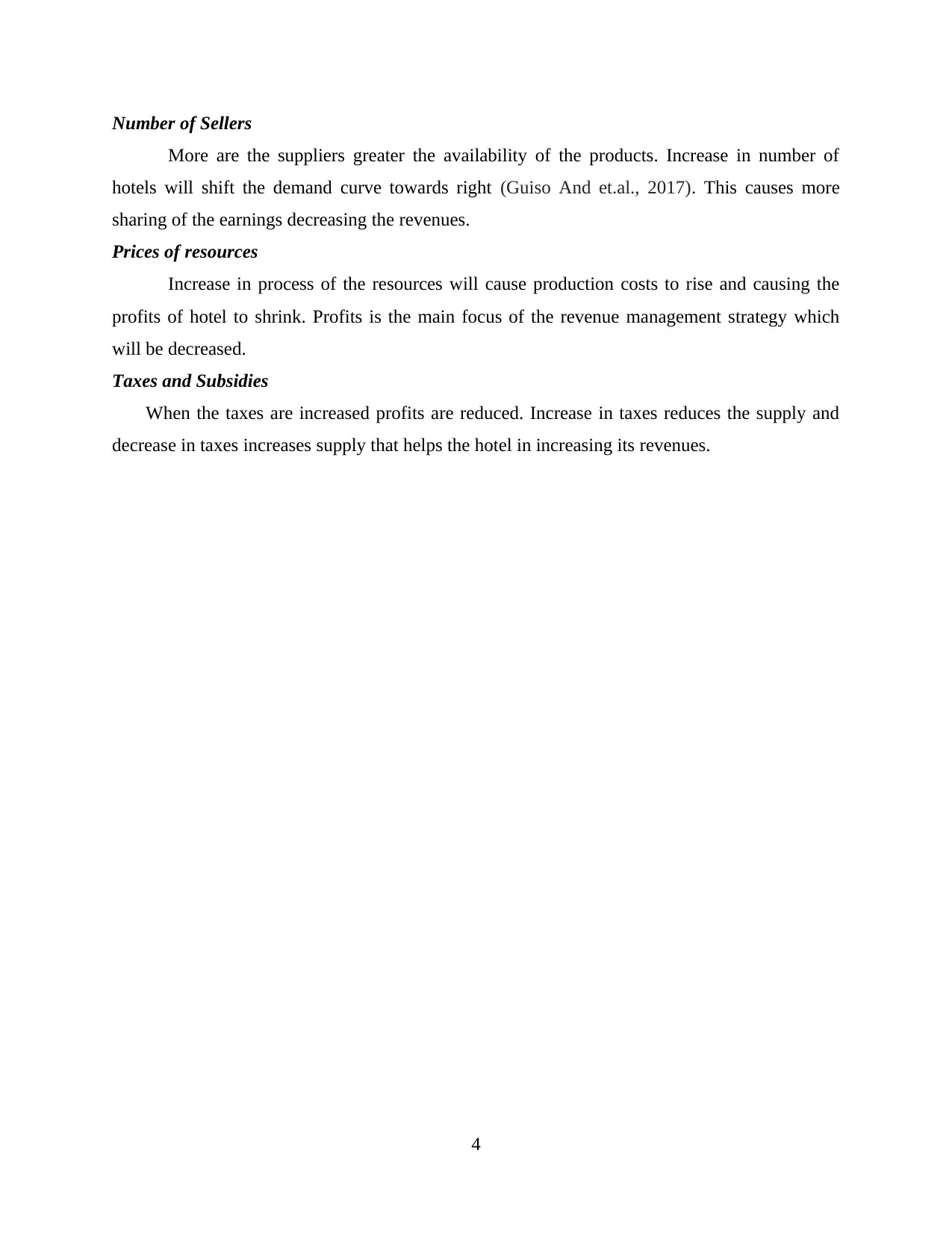
Number of Sellers
More are the suppliers greater the availability of the products. Increase in number of
hotels will shift the demand curve towards right (Guiso And et.al., 2017). This causes more
sharing of the earnings decreasing the revenues.
Prices of resources
Increase in process of the resources will cause production costs to rise and causing the
profits of hotel to shrink. Profits is the main focus of the revenue management strategy which
will be decreased.
Taxes and Subsidies
When the taxes are increased profits are reduced. Increase in taxes reduces the supply and
decrease in taxes increases supply that helps the hotel in increasing its revenues.
4
More are the suppliers greater the availability of the products. Increase in number of
hotels will shift the demand curve towards right (Guiso And et.al., 2017). This causes more
sharing of the earnings decreasing the revenues.
Prices of resources
Increase in process of the resources will cause production costs to rise and causing the
profits of hotel to shrink. Profits is the main focus of the revenue management strategy which
will be decreased.
Taxes and Subsidies
When the taxes are increased profits are reduced. Increase in taxes reduces the supply and
decrease in taxes increases supply that helps the hotel in increasing its revenues.
4
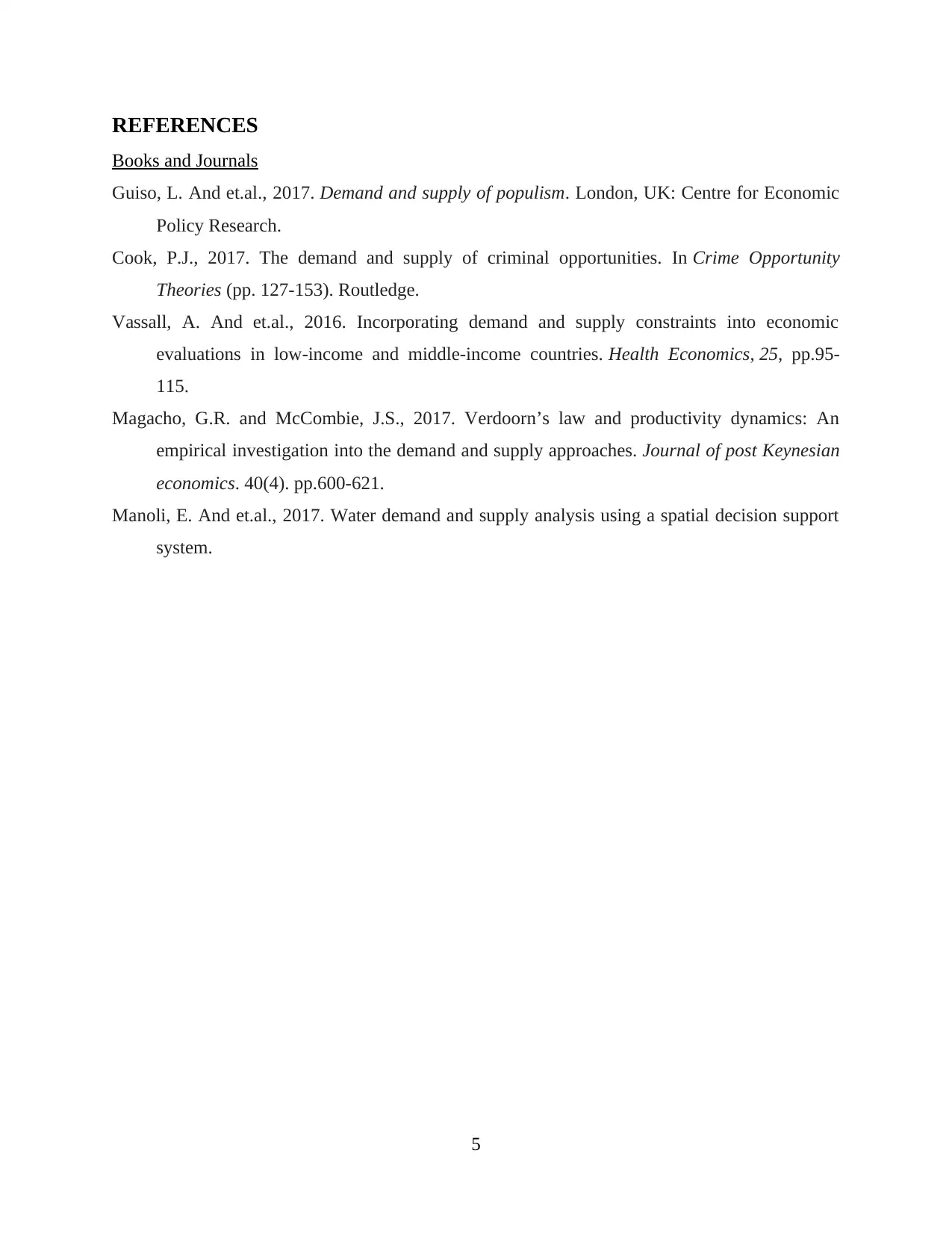
REFERENCES
Books and Journals
Guiso, L. And et.al., 2017. Demand and supply of populism. London, UK: Centre for Economic
Policy Research.
Cook, P.J., 2017. The demand and supply of criminal opportunities. In Crime Opportunity
Theories (pp. 127-153). Routledge.
Vassall, A. And et.al., 2016. Incorporating demand and supply constraints into economic
evaluations in low‐income and middle‐income countries. Health Economics, 25, pp.95-
115.
Magacho, G.R. and McCombie, J.S., 2017. Verdoorn’s law and productivity dynamics: An
empirical investigation into the demand and supply approaches. Journal of post Keynesian
economics. 40(4). pp.600-621.
Manoli, E. And et.al., 2017. Water demand and supply analysis using a spatial decision support
system.
5
Books and Journals
Guiso, L. And et.al., 2017. Demand and supply of populism. London, UK: Centre for Economic
Policy Research.
Cook, P.J., 2017. The demand and supply of criminal opportunities. In Crime Opportunity
Theories (pp. 127-153). Routledge.
Vassall, A. And et.al., 2016. Incorporating demand and supply constraints into economic
evaluations in low‐income and middle‐income countries. Health Economics, 25, pp.95-
115.
Magacho, G.R. and McCombie, J.S., 2017. Verdoorn’s law and productivity dynamics: An
empirical investigation into the demand and supply approaches. Journal of post Keynesian
economics. 40(4). pp.600-621.
Manoli, E. And et.al., 2017. Water demand and supply analysis using a spatial decision support
system.
5
1 out of 7
Related Documents
Your All-in-One AI-Powered Toolkit for Academic Success.
+13062052269
info@desklib.com
Available 24*7 on WhatsApp / Email
![[object Object]](/_next/static/media/star-bottom.7253800d.svg)
Unlock your academic potential
© 2024 | Zucol Services PVT LTD | All rights reserved.





